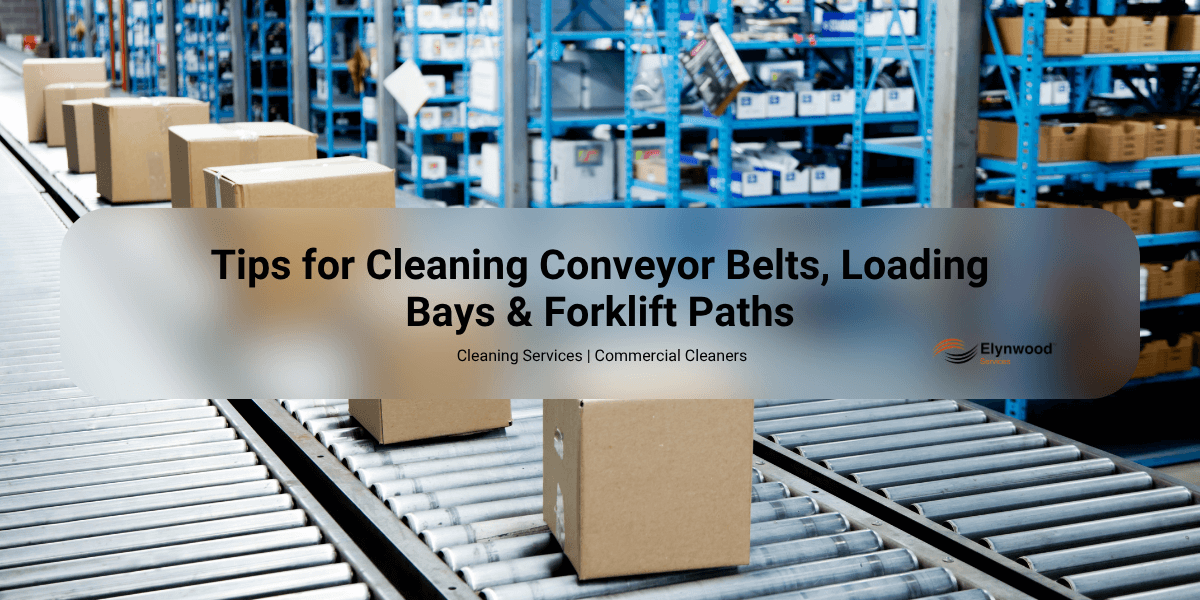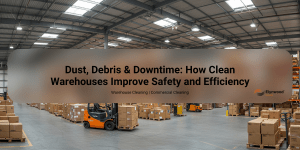In warehouses and logistics facilities, the areas that get used the most tend to get cleaned the least. Conveyor belts keep running, loading bays stay open, and forklifts move non-stop. Dirt, oil, dust, and waste build up fast and if left unchecked, they create safety hazards, slow down workflows, and add wear to expensive equipment.
A regular, structured cleaning plan isn’t optional in these environments. It’s a basic requirement to keep everything running without incident. Whether you manage a factory, a distribution centre, or a storage facility, the cleaning work you do or outsource in these three areas has a direct impact on safety, compliance, and daily performance.
Below, we’ll break down what matters most in Warehouse cleaning for conveyor belts, loading bays, and forklift paths.
1. Conveyor Belts: Clean Machinery Runs Longer
Conveyor belts carry product, waste, packaging, and all kinds of residue. The belt itself isn’t the only surface affected, the frame, rollers, guides, and motor areas also collect dust and debris over time.
Routine cleaning prevents:
- Belt tracking issues
- Premature wear on rollers and bearings
- Contamination in food or pharmaceutical handling
- Fire hazards in paper or cardboard-heavy facilities
Cleaning tips:
- Always isolate and lock out the system before beginning. Cleaning while powered is a serious safety risk.
- Vacuum or dry-brush loose debris before applying liquids.
- Use the correct cleaner for the belt material; some belts require food-grade, low-residue products.
- Clean both the top and underside of the belt, as well as rollers, motor housings, and support frames.
- Watch for fraying or cracking. Dirt hides damage.
- Check for oil or grease leaks from adjacent machines or gearboxes.
How often?
Daily wipe-downs for high-use belts. Deeper cleans weekly or fortnightly, depending on volume and risk profile.
2. Loading Bays: Keep Entry Points Under Control
Loading docks are exposed to external dirt, vehicle emissions, oil drips, weather changes, and constant foot and pallet traffic. These areas are the first to accumulate water, grime, and packaging waste and often the last to get cleaned because they’re always in use.
Common issues:
- Dust from trucks and nearby roads
- Oil stains and tyre residue
- Slippery surfaces from rain or condensation
- Waste build-up from broken pallets or discarded shrink wrap
Cleaning tips:
- Sweep floors daily, including the edges where debris settles.
- Use a degreaser or detergent to break down oil spots before they stain the concrete.
- Pressure wash weekly or as needed high-pressure water is effective in reaching grooves and rough surfaces.
- Clean dock levellers and seals. These areas trap moisture and dirt but are often overlooked.
- Empty bins and sweep down nearby walls, corners, and safety rails.
- Remove standing water quickly, especially near dock doors.
When to clean?
Ideally, clean during scheduled delivery gaps or after hours. Cleaning around moving trucks increases risk and slows both processes down.
3. Forklift Paths: Clean Floors, Clear Routes
Forklifts carry more than product. They also bring in dirt from outdoor yards, leak oil or hydraulic fluid, and wear down surface paint over time. Because these paths are in near-constant use, they’re also easy to ignore until something goes wrong.
Risks include:
- Slippery floor spots causing wheel spin or operator slips
- Faded hazard lines and signs reducing visibility
- Dust and debris interfering with sensors on modern electric or automated forklifts
Cleaning tips:
- Dry sweep forklift lanes every shift. This removes fine dust, loose parts, and tracked-in grit.
- Scrub with a ride-on floor cleaner once or twice a week, depending on volume.
- Use low-foam degreasers to clean spills or patches from leaking units.
- Repaint safety lines as soon as visibility drops. Faint or missing lines compromise pedestrian and vehicle safety.
- Inspect junctions and sharp turns debris often collects there.
- Consider installing oil-absorbent mats or floor seals in high-risk zones.
Cleaning schedule:
Set cleaning for quiet periods or end-of-shift to avoid interrupting loading runs. For high-traffic warehouses, daily cleaning is standard.
4. Record-Keeping: Cleaning Logs and Compliance
These areas aren’t just prone to build-up; they’re often audited. Whether it’s internal compliance, external safety inspections, or client expectations, having a clear record of what gets cleaned, how often, and by whom matters.
Basic log should include:
- Date and time of each clean
- Name or initials of the person/team responsible
- Area cleaned and type of work done
- Notes on hazards, leaks, or equipment damage
Logs should be kept for at least 6–12 months depending on site policy. Digital checklists are common, but paper logs near entry points work just as well when used consistently.
5. Assign Responsibility And Make It Stick
The best cleaning plan fails if it’s everyone’s job but no one’s task. Set clear responsibilities for these high-use areas.
- Internal teams can handle daily wipe-downs, sweeping, and quick response to spills.
- Deeper cleans (e.g. pressure washing, belt stripping, scrubbing forklift lanes) should be managed by trained staff or an external cleaning partner.
- Supervisors should inspect weekly and report damage, blockage, or repeat issues.
Consistency matters more than intensity. Regular, moderate cleaning does more than occasional deep work followed by long gaps.
Final Thoughts
Conveyor belts, loading bays, and forklift paths carry the weight of daily operations. When they’re clean, they run smoother, last longer, and create fewer safety concerns. The key is regular upkeep and knowing what each area needs.
If your facility needs support keeping high-use areas clean, Elynwood works with warehouses, food storage sites, and logistics operations across Australia. We handle large-scale cleaning jobs with a focus on safety, compliance, and getting work done around your operating hours.
FAQ
1. Why is cleaning conveyor belts so important?
A. Regular cleaning of conveyor belts prevents issues like belt tracking, premature wear on rollers and bearings, and contamination (especially in food and pharmaceutical facilities). It also reduces the risk of fire hazards and extends the life of the equipment. Cleaning should include both the top and underside of the belt, rollers, motor housing, and support frames.
2. How often should loading bays be cleaned?
A. Loading bays should be swept daily to remove debris and waste. A deeper clean, including pressure washing, is recommended weekly or as needed to address oil stains, grime, and waste buildup. Cleaning during scheduled delivery gaps or after hours helps avoid disrupting operations.
3. How do I keep forklift paths clean and safe?
A. Forklift paths should be dry swept at the start of each shift to remove fine dust and grit. Regular scrubbing (once or twice a week) is essential, especially for high-traffic areas. Spills should be cleaned with low-foam degreasers, and faded safety lines should be repainted promptly. Regular inspections for debris and high-risk zones, like oil-absorbent mats, help ensure safety.
4. What should be included in a cleaning log for compliance?
A. A good cleaning log should include the date, time, area cleaned, the person responsible, and details of the work done. It should also note any hazards, leaks, or equipment damage. Keeping these logs for at least 6–12 months helps with internal audits and safety inspections.
5. How can I ensure the cleaning plan is effective?
A. To ensure the plan is followed, assign clear responsibilities for each area. Internal teams can handle daily tasks like sweeping and wiping down surfaces, while more intensive cleaning (like pressure washing and deep scrubbing) should be managed by trained staff or an external service. Regular inspections and consistent cleaning help maintain efficiency and safety.






